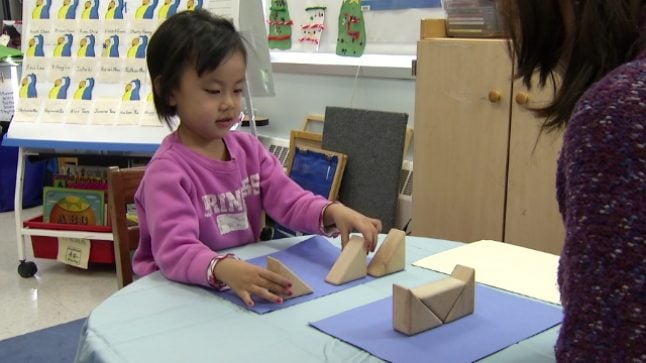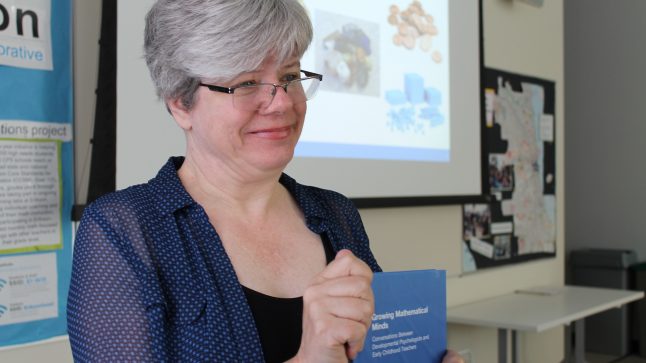Preschool Math
Series: Focus on the Child
Many Ways to See How Many
January 29, 2019
Regardless of how high a preschooler can rote count, a child’s sense of what those numbers actually mean develops gradually. We call this understanding number sense, and it requires relating numbers to real quantities.
- Topic: Number Sense
- Age/Grade Level: Pre-K, Kindergarten
- Tags Estimation, Unifix Cubes, Subitizing, Gesture, Dot cards
Series: Book Ideas January 11, 2019
4 Fun Books that Explore Math, Patterns, and Sequences
From an early age, children notice and appreciate patterns in the world around them. Patterns and sequences of different kinds begin to pop up all over the place, especially in the books that children love.
- Topic: Pattern
- Age/Grade Level: Pre-K, Kindergarten, 1st Grade
- Tags Animals, Eric Carle, Bill Martin Jr., Trudy Harris, Audrey Wood, Pattern Bugs, Brown Bear Brown Bear What Do You See?, I Went Walking, The Napping House, Sue Williams
Series: Focus on the Child December 12, 2018
Transforming Three-Dimensional Shapes with Child 36
This child successfully attempts to match geo-solids using triangular prism-shaped blocks. Focus on the Child videos are taken from one-on-one interviews with individual children. The interviews are designed to elicit evidence of children’s mathematical thinking.…
- Topic: Spatial Relationships, Shape
- Age/Grade Level: Pre-K, Kindergarten
- Tags English Language Learner, Child 36
Series: Focus on the Child December 10, 2018
One-to-One Correspondence with Child 15
A child counts an organized collection of bears. Children often sort collections into groups by color. Here, a preschooler assumes he has equal groups until he counts them.
- Topic: Counting
- Age/Grade Level: Pre-K, Kindergarten
- Tags Child 15
Series: Ideas at Work November 7, 2018
Counting on Good Food for the Holidays
Traditions around food and feasts provide rich opportunities to connect math at school with children’s experiences at home. From Diwali to Thanksgiving, fall is a season of special meals with loved ones.
- Topic: Counting
- Age/Grade Level: Pre-K, Kindergarten, 1st Grade
- Tags Seasonal, Holiday, Cathryn Falwell, Family Math, Feast for 10
Series: Hear from the Experts October 23, 2018
Creating Opportunities for Early Math with Rodrigo Gutiérrez
The role of play and importance of shared experiences in early math is discussed with Rodrigo Gutiérrez, Co-Director of the Center for Retention-Recruitment for Math Teachers at University of Arizona.
- Age/Grade Level: Adult Learners, Pre-K, Kindergarten, 1st Grade
- Tags Culture, Promising Math
Series: Book Ideas October 22, 2018
A Holiday with Too Many Tamales
How is it possible to have too many tamales? Well, Maria finds out in the holiday storybook Too Many Tamales by author Gary Soto.
- Topic: Number Operations
- Age/Grade Level: Pre-K, Kindergarten, 1st Grade, 2nd Grade, 3rd Grade
- Tags Seasonal, Food, Holiday, Books, Gary Soto, Family Math, Too Many Tamales
Series: About the Collaborative October 3, 2018
New Book Connects Early Math Teaching with Developmental Research
A new book released in August 2018 from the Collaborative examines the connections and questions that arise from discussing math experiences in early childhood settings and the research into children's mathematical learning.
- Age/Grade Level: Pre-K, Kindergarten, 1st Grade, 2nd Grade, 3rd Grade
Series: Focus on Play September 26, 2018
The Match ‘Em All Game
This bingo-like game allows children to think about numbers in different ways. It focuses children on the attribute of quantity of small sets and helps them build a more robust number sense.
- Topic: Number Sense
- Age/Grade Level: Pre-K, Kindergarten
- Tags Unifix Cubes, Subitizing, Games, Dice
Series: Focus on Play September 25, 2018
The Hoop Game
This game played with a hula hoop and bean bags demonstrates all the math that can be explored with a simple tossing game. Each round gives children practice seeing and naming smaller parts of a…
- Topic: Number Sense
- Age/Grade Level: Pre-K, Kindergarten
- Tags Subitizing, Games, download
Do the math.
Free videos.
Free newsletter packed with ideas.
Free professional learning modules.









